KLIM Badlands Pro: Separating the Skin from the Ground

You’d think blue was my favorite color.
As I’ve most likely mentioned elsewhere, I’m an odd shaped duck. Seems like ¾ of my 6’ frame is from the waist up, I have a bit of a gut, broad shoulders and a barrel chest. If I road Harley’s like most people think I do, I’d probably have no problem finding a jacket. But I prefer sport bikes, which means most riding gear is designed for Italian jockey’s. Seriously, what is it about cycling and motorcycling where everything’s designed in miniature, and are all Italians 5’ tall and 100#? Last time I tried on a Dainese jacket I was getting into something like the 6XL range. I’m a big guy, but not that big. Suffice it to say, finding a jacket to fit my bulky frame is generally difficult.
As such, I’ve historically ridden in Joe Rocket textile jackets since they apparently design things a bit closer to normal human sizes, even if their quality is often somewhat suspect. At one point I was small enough to fit into an actual leather jacket from Alpinestars. You can see all of the jacket’s I’ve ridden in over the last decade in the first picture, although only two of them are what I’d consider useable at this point. What follows is in the end a review of the KLIM Badlands Pro but to get there I have to explain the thought process which got me to the point of purchasing this jacket.
As noted before, in August of 2016 I rode the Trans America Trail with my brother from PA to CA, roughly 4,500 miles in all conditions and to do that I needed the right jacket. Being new to dirt riding in general and overland-style riding at that I was essentially going in blind. First, I wanted to use something I already had, which meant either the leather jacket or one of the two textiles.
Alpinestars Leather Jacket:
Standard sportbike set-up. Perforated leather, stretch panels in non-impact areas, very little storage and tight fitting. In short, not an option for an adventure ride, especially being leather.
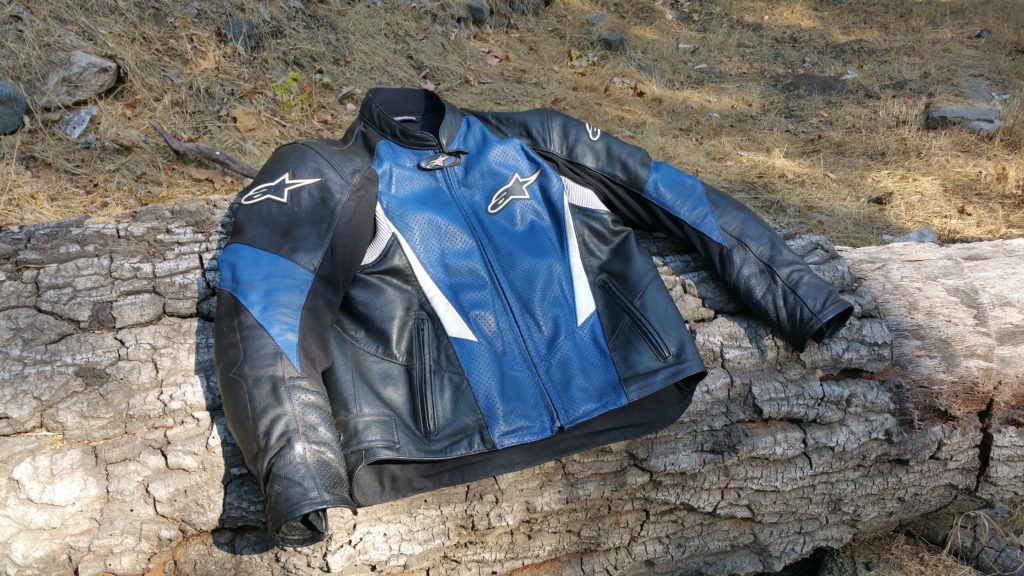
Old Joe Rocket Jacket:
I actually forgot I even had this in the closet, but still wouldn’t have used it as an option as it was too old, too floppy and just plain run down. But, it’s worth showing here to show the wear and tear of most cheaper textile jackets, as well as some of the worthless junk they add to look cool. All that rubber on the shoulders and forearms is just weight, wind resistance, and a grip to tear off when the going gets bad.


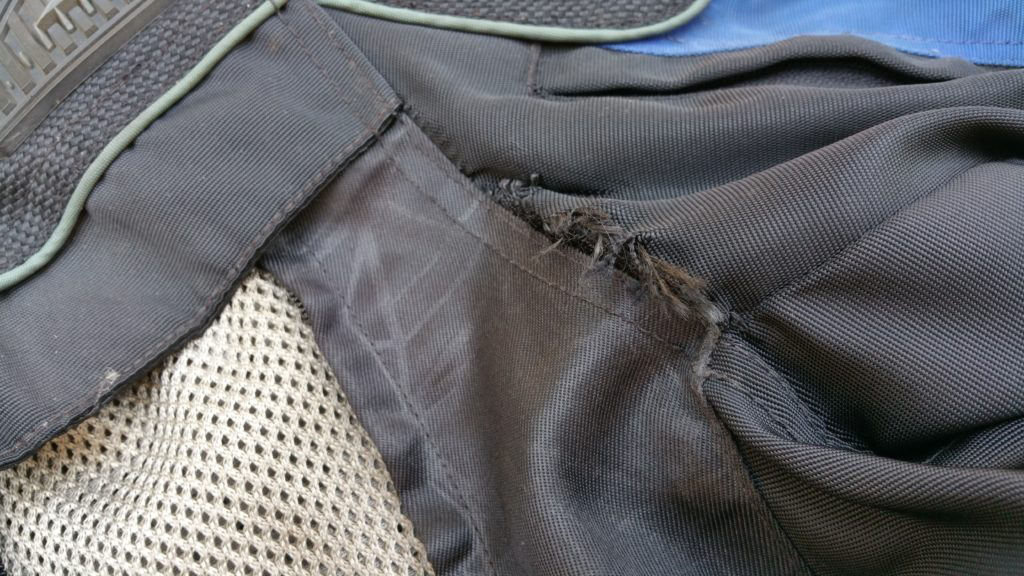
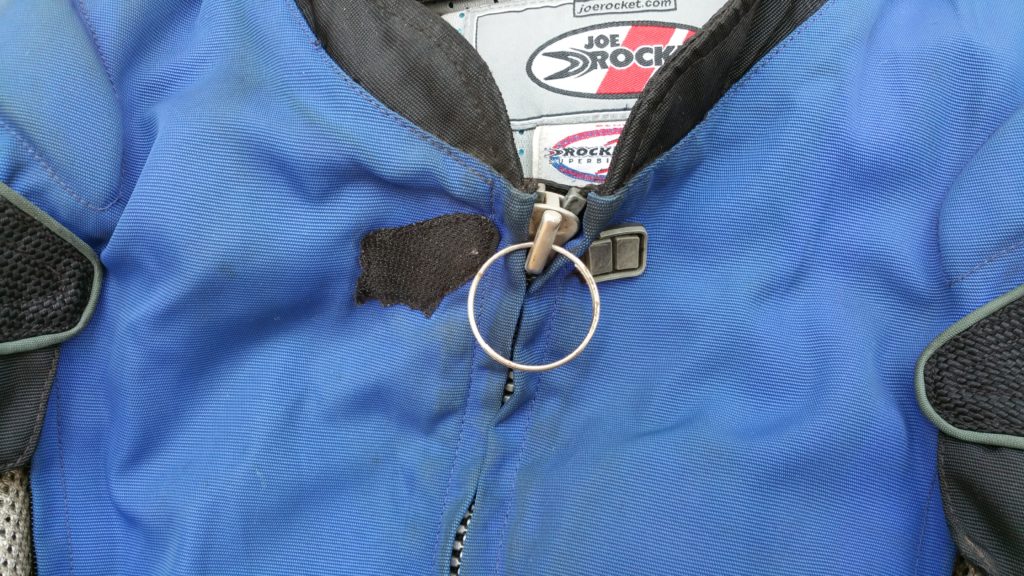
Newer Joe Rocket:
Now we’re getting into the details of my master plan, where I took my nicely fitting textile street jacket

and put it over a Leatt 5.5 body protector or similar:

At $270, give or take, these aren’t cheap, but there are other brands out there for much less money, and that’s not a horrible price for the overall protection. My brilliant plan was to wear just the Leatt on the trails to stay cool and protected and toss on the old textile over the top when things got cold or street oriented. If it rained, I’d just toss on a rain jacket under all of it. In retrospect, this probably would have worked, but not well. First, I would have ended up being dustier than the trails over which we’d be riding. Not a big deal at the track or for sag wagon supported ride with a shower at each stop, a very big deal when time becomes compressed and you’re going to bed unshowered in your sleeping bag. Further, given how amazingly wet our ride was, I would have either been soaked to the bone from the rain, soaked to the bone from sweating under the rain jacket, or some combination of unprepared and uncomfortable. Lastly, these body protectors operate on the underpinnings of compression shirts, which means I’d be wearing a compression garment for 15hrs a day, for 14 days. Not sure how comfortable – or durable – that would be. In the end, the choice was made for me because on my first major test ride of the DR650, my jacket irreparably broke.

I was able to finish the ride trip, if unsafely, by utilizing the neck snap, chest snaps, drilling two holes into the stomach area and clipping with a mini-carabiner, and then using a tie-down strap for the hip area. I’m sure it was a sexy, safe look. Problem was, I now needed a new jacket, let alone off-road and rain protection.
Herein lay my new quandary: Given an extremely tight budget, the needs of the ride (waterproof, street crash resistant, dirt trailable, storage if possible, fits me), what type of jacket to I buy?
While most any jacket could work, I decided to stay within the realm of textile all-weather jackets as they’d already have considered the basics for me. My first thought was for an off-the-shelf Motoport jacket as their pants have proven to be insanely durable, but they were priced out of my wallet. I then went to the local stores and tried on everything available from all of the standard brands but came down to two: Olympia Expedition or one of the lower models (Ranger & Dakar) and KLIM Badlands Pro.
General Jacket Considerations
Fabric:
I honestly thought KLIM jackets were made from the higher numbered Cordura fabrics (600, 1000, 2000) but it turns out they’re made from a fancy Gore-Tex Pro Shell something. I’ll have to research more on this but I can say that KLIM has proven very durable for myriad riders over the years and I personally saw my brother slide on asphalt in a pair of their pants with no wear marks whatsoever, like it didn’t happen. Olympia uses the higher numbered Cordura fabrics which is acceptable as well. Many of the other brands use a lesser polyester fabric which can actually melt into wounds under the friction of an accident, which is a deal breaker for me. Motoport uses a Kevlar weave and has convinced me of their quality and durability which I’ll detail in a review about my pants.
Waterproofing:
Olympia shares the same general school of thought regarding waterproofing as Motoport, where the waterproof layer is literally a separate layer. This avoids the weight and cost of Gore-Tex as well as allowing greater breatheability. There is a good argument to be had here, but I found it to be a frustrating compromise, as that was the choice I went with on my pants. Put simply, my pants are pure mesh which is great everywhere except when it rains. Problem is, on long trips rain can be a fickle mistress, as can temperatures, and going back and forth with liners when the weather varies or sticking with one and suffering half the time is time consuming and frustrating. I’ve found a little rain doesn’t tend to get through regular motorcycle clothing and with as much as I sweat just existing, I wear quick dry clothing underneath regardless, so I’d hold off on layering for rain as much as possible, sometimes to my well soaked lament. For my pants, for me, this was okay but to do so with the jacket would be problematic.
Armor:
This can get wonky to figure out what’s best for what where, but the general gist is the more the better, and if it’s CE certified all the better. Modern adventure armor tends to be more like non-Newtonian fluid where it’s basically both hard and soft, depending on the impact. Olympia, KLIM and Motoport all use acceptable armor, lower end jackets may as well be (or in fact are) foam.
So why didn’t I go with the Olympia Expedition? Because I found a KLIM Badlands Pro on sale in my size.

I’ll put this simply: Quality, Durability, Feature filled. All for an insanely expensive price.
I’ve detailed some of the quality features above, but one look at their products reveals just how well made these things are. And I’m not just talking about looking at the jackets on the rack, I’m talking about the dirty, grimy, 5 year old jacket on the guy who’s been there and back and had to barter with a watch to live to tell about it. Yeah, that jacket says quality because it’s still working.
I’ve seen what didn’t happen to my brother’s pants when he said hello to the ground. To be fair, two years after the low side he was prepping for the TAT trip and upon further review found one stitch to be frayed where it hit the ground. He thinks. Probably. I myself have had two dismounts in the Badlands jacket, one at about 20 MPH fully loaded on a slimy Mississippi backroad where I skidded into a ditch, and the other in CA when I lost the front end in a soft but very steep gully. First one I slid to a stop the entire left side of my body coated in clay and the second I supermanned over the handlebars, rolled over like a Karate master in soft dirt with sticks and got a little dusty. The jacket shrugged these off like I’d thrown a feather duster at it. As for me, no bruises, scrapes or any sign of impact. One side-note here, going back to the armor, is that the Badlands has chest armor whereas most jackets do not. I found this to be very handy and thought it a nice feature.
Rain was an interesting issue. While having to stop and layer up to waterproof is annoying, so is stopping to zip up every single ventilation zipper. Let’s see, two under the pits, two on the forearms, two on the back, the collar. The two under the pits are actually quite difficult to zip up on your own, so I’d usually ask my brother to assist, and he me. You could make the case that layering or zipping takes the same amount of time for rain, but the truth is I rarely zipped up. Yes, when the skies darkened, thunder boomed, and lightning said hello, yes, I’d zip up, but in all but the most severe storms I simply left everything open. Surprisingly little water came through, mostly from the forearm zippers. Note that I live hot, I’m a heater in a human body, so if you’re more normal leaving the waterproof layer on or the zippers up all day won’t worry you, in which case you have more options than I present here.
Okay, so it’s safe and dry, how’s that worth the crown jewels in cash? Actually, those two things carry most of the cost, but you’re also getting well thought out features. The front of the jacket has a non-waterproof pocket good for quick items like keys and earplugs, plus two waterproof chest pockets and two waterproof lower pockets.
The front left arm has a yellow waterproof pocket with an asterisk star-of-life thingy on it for your ID.
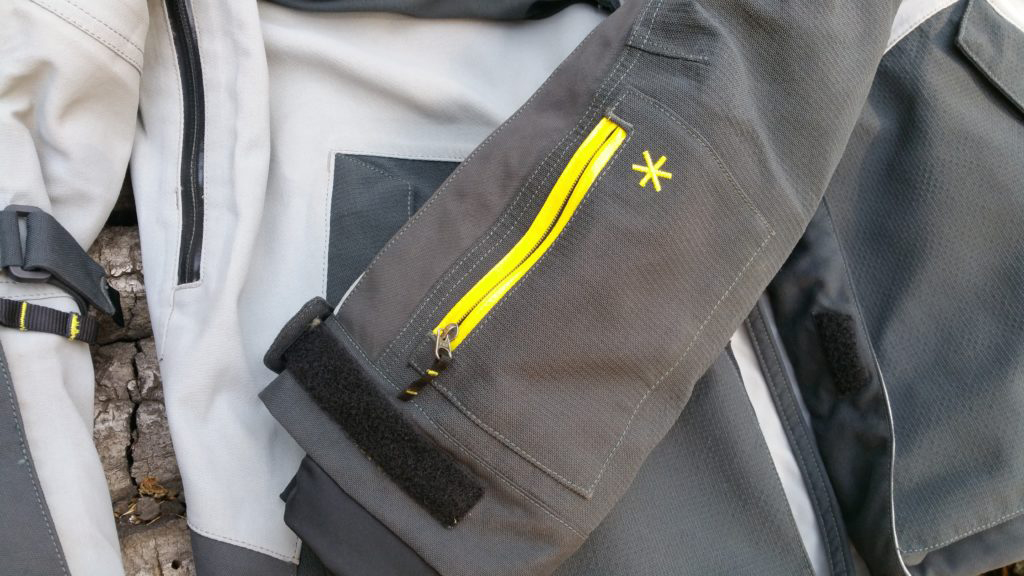
On the lower back is a cavernous pocket for something huge, maybe a baby carriage or your Rottweiler,
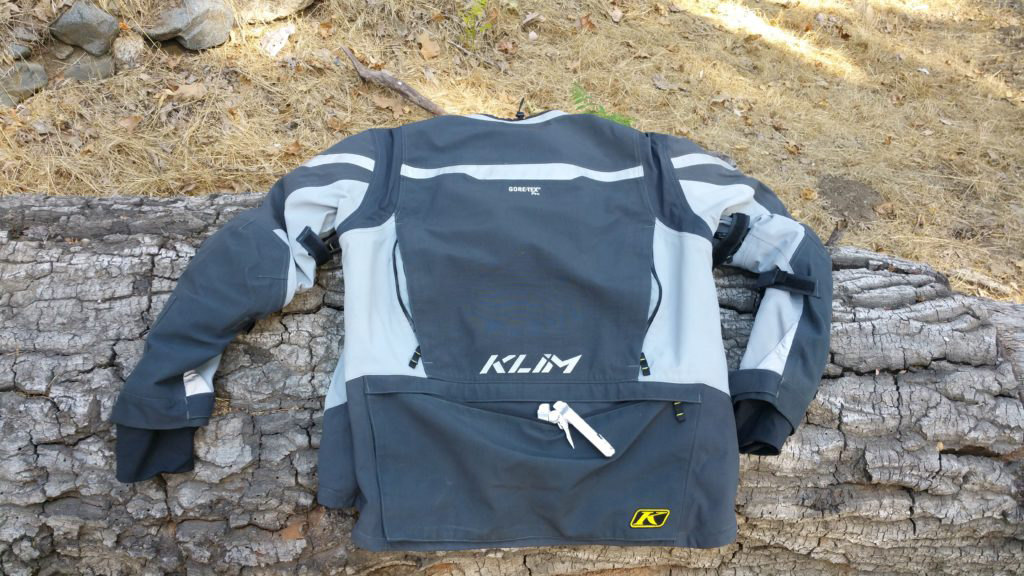
Inside the pockets are a little less durable or good for snaggable items, but they are equally abundant and useable. Biggest gripe on these is I always mistake the chest padding openings for pockets.

One little detail I always forget about – which is exactly the point, is the little hidden pocket by the left hip. It’s deliberately sewn behind a seam to be hidden and a perfect place to store valuables like spare cash and copies of passports.
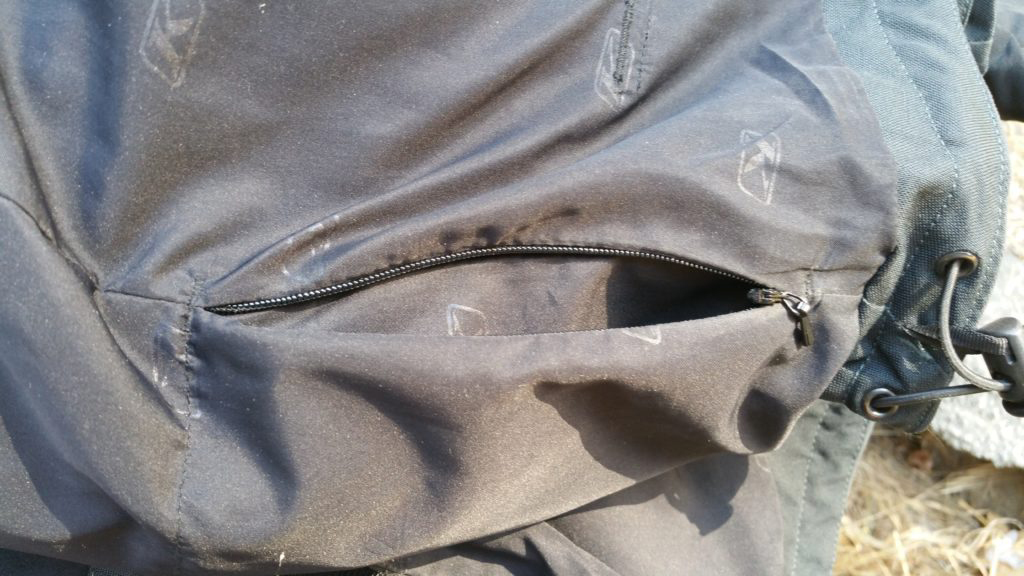
There are a few other details which can be nice, like the drawstring waist and neck. Point of fact, most of the other jackets I’ve worn have Velcro straps to cinch the waist, which causes the side to bunch up and reduce protection. The zipper stop at the throat has a pocket;

the lapels have Velcro to which to attach the collar for extra ventilation; the front zipper is covered by two flaps, one of which is double seamed so as to create a reasonably waterproof barrier;

the top of the collar is covered in a soft material for neck comfort; there’s a hip belt to better carry the jacket under load;
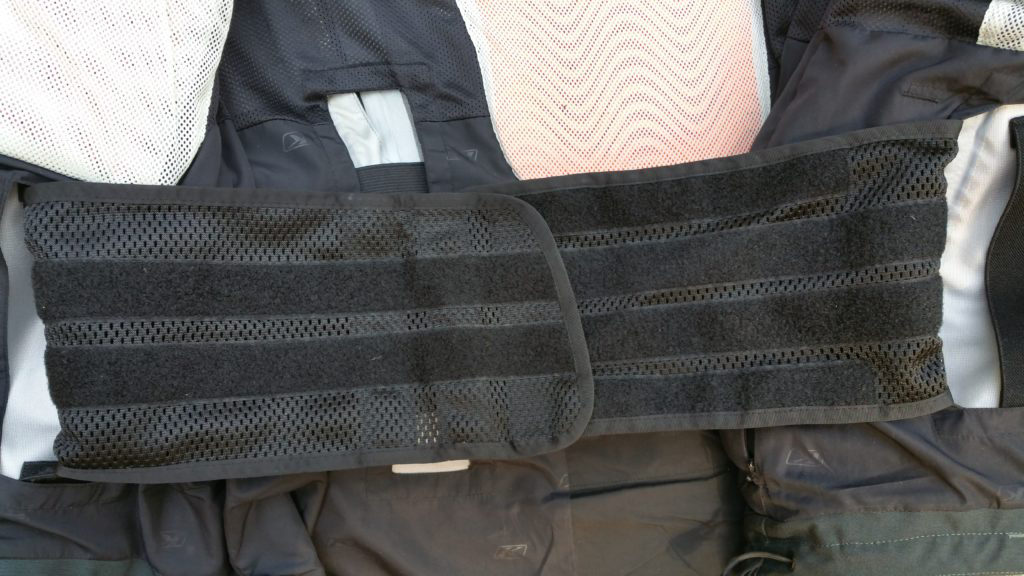
the back has an integrated pocket for a water reservoir as well as dedicated ports to get that to your mouth, and so on.
I will say there are several things which are annoying or have to be lived with.
The collar is too tall. It is always in the wrong spot when fully zipped and loves to annoy my Adam’s apple. It ends up being bent down by the helmet and mostly out of the way.
The water reservoir on the jacket I have requires removing the back padding. Not impossible, just annoying. I believe more recent jackets have fixed this. I’d probably limit it to a 1 liter capacity just for the sake of weight.
The pull tab for the neck frequently knocks the helmet so my helmet cam footage often has a clicking sound. I actually stopped a few times during the ride to figure out what that sound was ‘til my brother pointed it out.
I utterly hate the monkey paw.

Putting on the jacket involves me putting my arms through the jacket, pushing all the way through to extend the paw, pushing the paw back in why retracting my arm and then closing the cuff. I will be cutting those things out ASAP. It should be noted the newer jackets don’t have this miserable feature, although my brother liked it. Further, I’m the type to wear a gauntlet over the jacket so having cold air drive up my arm isn’t a problem. Plus, I’m always hot so it still wouldn’t be a problem. I cannot express how much I loathe the monkey paw, such a stupid thing. Of course, my always cold brother likes it so if that’s you, there you go.
This thing is HEAVY. Seriously, putting on the jacket requires a pep talk when you’re hot at the end of a tough ride. You feel every metric ton of this beast when carrying it around or trying to put it on. That said, once on it carries its weight very well and never gets in the way and if you actually remember it the hip belt really does help.
While neither a pro no con, it’s worth noting that you must be careful laundering the jacket. First, it requires liquid detergent and a front load washer, neither being a big deal. However, it also notes that you need to zip up every zipper, as most of them are the fancy waterproof style. Given that this jacket is basically one large zipper, I forgot the back zippers and tossed it into the wash, resulting in some damage, although none from which I’ve noticed any ill-effects.

Note the light colored wear at the edge of the rubber seal.
Further, the reflectors tend to bubble up a bit after a laundry wash and I’ve heard rumor of them eventually peeling completely off. Shouldn’t effect waterproofing or anything, but is a bit annoying.
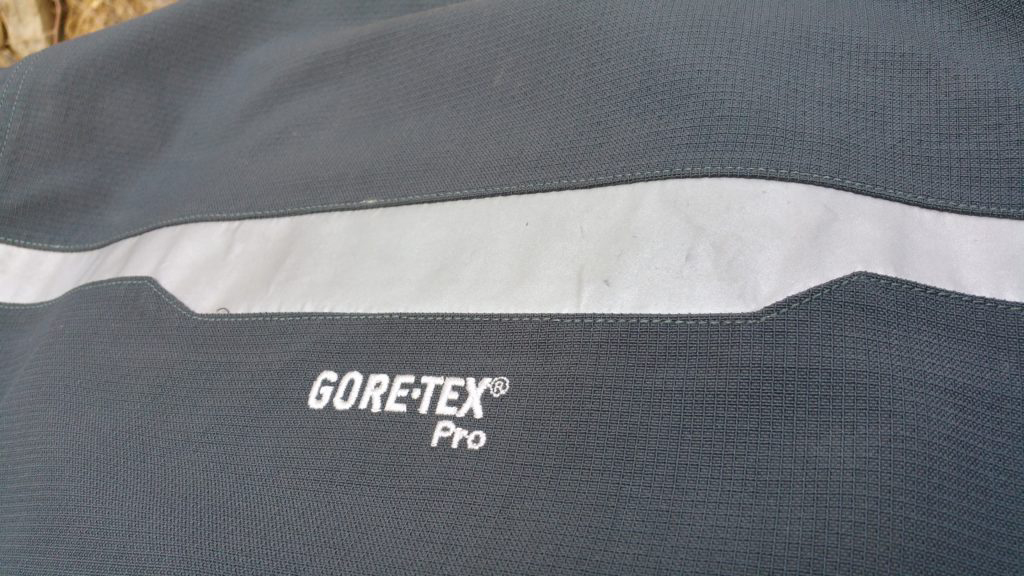
I rarely laundry wash my jackets, usually just spraying them down, but adventure rides get crazy dirty and stinky, so bear that in mind.
So when you’re ready to pull out the wallet and dump a wad of hard-earned cash on a jacket, should you get this one? Maybe. I highly recommend this jacket and if you decide to purchase it you have not made an unsafe choice and in fact will probably love this thing for years to come. However, it is punitively expensive and on top of that, costs a lot of money. For the $1K+ this or similar KLIM items cost I’d have to seriously consider a custom Motoport jacket or the Olympia. However, the features and quality of the KLIM are hard to beat. What type of riding do you plan to do? If you’re a weekend warrior, $1K+ is mostly conspicuous consumption, buying the best of the best because you can, but you’d be equally, possibly even better served by a less expensive option. Depends on which features you consider the most important. If you’re an all-weather commuter or serious adventure rider, then the KLIM definitely warrants a look.
Comes down to opportunity cost. If you cannot afford the KLIM, a less expensive jacket will still service you in every way you require, no regrets. If you can afford the KLIM, I absolutely recommend it and can say that with 10K of real adventure riding with one.






Comments are closed here.